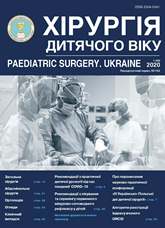Model substantiation of spatial parameters of surgical access in mini-invasive surgical treatment of pilonidal disease in children
DOI:
https://doi.org/10.15574/PS.2020.66.10Keywords:
pilonidal disease, children, cyst, spatial model, surgical accessAbstract
Dissatisfaction with the results of treatment of pilonidal disease in children leads to the search for new ways to improve the methodology of its surgical treatment.Objective: To create a model for the spatial justification of the form and parameters of surgical access in the treatment of pilonidal disease in children in all forms of it.
Materials and methods. On the basis of anatomical and spatial studies of sacral-coccygeal area in 50 patients with pilonidal disease, the prognostic factors of its course in children have been determined.
Results. Based on the data obtained, the main conceptual assumptions and recommendations for the removal of the pilonidal cyst were identified. In all cases the developed model of calculation of parameters and localization of operative access allowed to observe the minimally invasive direction of surgical treatment. Depending on the location, size and location of the fistulas of the pilonidal cyst, a spatial model, based on the ratio of elliptical planes, allows to determine the necessary parameters of the surgical wound, which allows to maximally lateralize the surgical wound with a minimum area of soft tissue removed.
Conclusions. The formation of contours, localization and parameters of intraoperative access in pilonidal disease in children, according to the developed model of spatial justification of the form and parameters of operative access, testifies to the feasibility of its elliptical shape, the parameters of which are determined by the location of the external openings of the fistulous passages in relation to the relation. The contour of the surgical wound in the form of an ellipse with well-defined geometric parameters of the calculated object allows to perform mini-invasive plastic surgery when removing the pilonidal cyst without additional formation of perianal skin and subcutaneous fat flap, which allows to reduce the number of postoperative lesions.
The research was carried out in accordance with the principles of the Declaration of Helsinki. The study protocol was approved by the Local Ethics Committee of all the institutions mentioned. Informed agreement was obtained from the parents of the children (or their guardians) for the research.
The author declares that there is no conflict of interest.
References
Dolgikh OB, Solov`ev OL, Stolyarov SA, Supil`nikov AA. (2013). Gemorroj. Samara: Reviaz: 152.
Kartashkin VA, Sapin MR, Shestakov AM. (2010). Osobennosti stroeniya naruzhnogo sfinktera pryamoj kishki u detej razlichnogo vozrasta. Rossijskij mediko-biologicheskij vestnik 1(18): 18-24.
Lurin IA, Tsema IeV, Yakimov DYu, Makaroff HH. et al. (2013). The Results of Minitraumatic Surgical Treatment of Patients with Chronic Pilonidal Sinus Disease with Using Bascom’s Procedure — Cleft Lift Procedure. Ukrainian Journal of Minimally Invasive and Endoscopic Surgery 17(4): 15-21.
Rusak OB. (2015). Substantiation of the effectiveness of the use of Octenisept® antiseptic in the treatment of epithelial coccygeal suppuration. Scientific Journal ScienceRise. 10(3): 153-157. https://doi.org/10.15587/2313-8416.2015.52179
Titov AYu, Kostarev IV, Batishhev AK. (2015). E`tiopatogenez i khirurgicheskoe lechenie e`pitelial`nogo kopchikovogo khoda Russian Journal of Gastroenterology, Hepatology, Coloproctology. 2: 69-78.
Abo-Ryia МН, Abd-Allah HS, Al-Shareef MM, Abdulrazek MM. (2017). Fascio-adipo-cutaneous lateral advancement flap for treatment of pilonidal sinus: A modification of the Karydakis operation-cohort study. World J. Surg. 12: 93-105. https://doi.org/10.1007/s00268-017-4406-8; PMid:29270650
Bali І, Aziret М, Sozen S. (2015). Effectiveness of Limberg and Karydakis flap in recurrent pilonidal sinus disease. Clinics (Sao Paulo). 15: 350-355. https://doi.org/10.6061/clinics/2015(05)08
Bascom J. (2008). Surgical treatment of pilonidal disease. BMJ. 366: 868-871.
Doll D, Matevossian E, Luedi MM. (2015). Does full wound rupture following median pilonidal closure alter long-term recurrence rate? Med Princ Pract. 6(24): 571-577. https://doi.org/10.1159/000437361; PMid:26334688 PMCid:PMC5588279
Haider К, Ashfaq А, Ishtiaq АК. (2017). Pilonidal sinus: a comparative study of open versus closed methods of surgical approach. JIIMC. 2: 111-115.
Sanz NM, Ros EP, Cifuentes AS. (2016). Modified Karydakis procedure for giant pilonidal sinus. GIR. ESP. 10(94): 606-613. https://doi.org/10.1016/j.cireng.2016.11.014
Stauffer VK, Luedi MM, Kauf P. (2018). Common surgical procedures in pilonidal sinus disease: A meta-analysis, merged data analysis, and comprehensive study on recurrence. Sci Rep. 8: 30-58. https://doi.org/10.1038/s41598-018-20143-4; PMid:29449548 PMCid:PMC5814421
Downloads
Published
Issue
Section
License
The policy of the Journal “PAEDIATRIC SURGERY. UKRAINE” is compatible with the vast majority of funders' of open access and self-archiving policies. The journal provides immediate open access route being convinced that everyone – not only scientists - can benefit from research results, and publishes articles exclusively under open access distribution, with a Creative Commons Attribution-Noncommercial 4.0 international license(СС BY-NC).
Authors transfer the copyright to the Journal “PAEDIATRIC SURGERY.UKRAINE” when the manuscript is accepted for publication. Authors declare that this manuscript has not been published nor is under simultaneous consideration for publication elsewhere. After publication, the articles become freely available on-line to the public.
Readers have the right to use, distribute, and reproduce articles in any medium, provided the articles and the journal are properly cited.
The use of published materials for commercial purposes is strongly prohibited.

